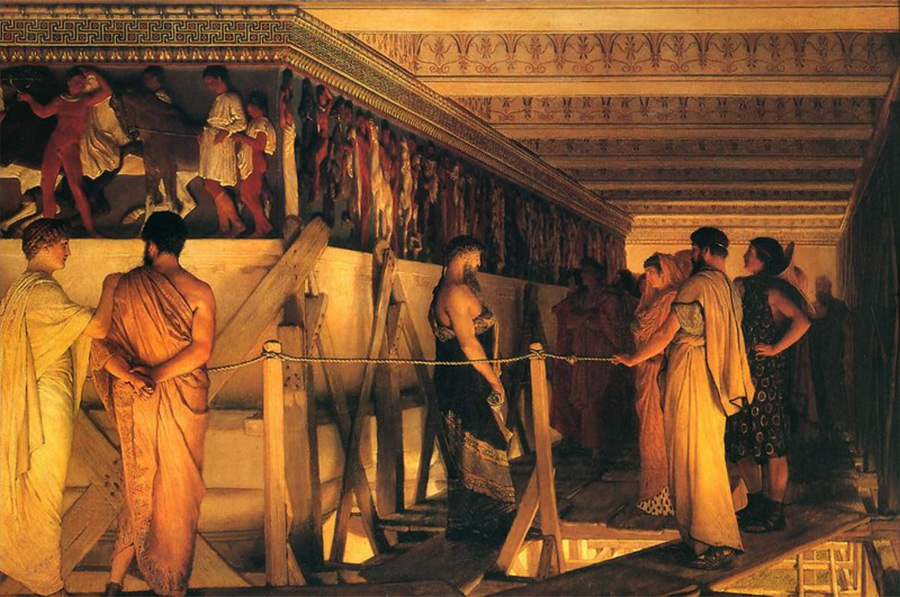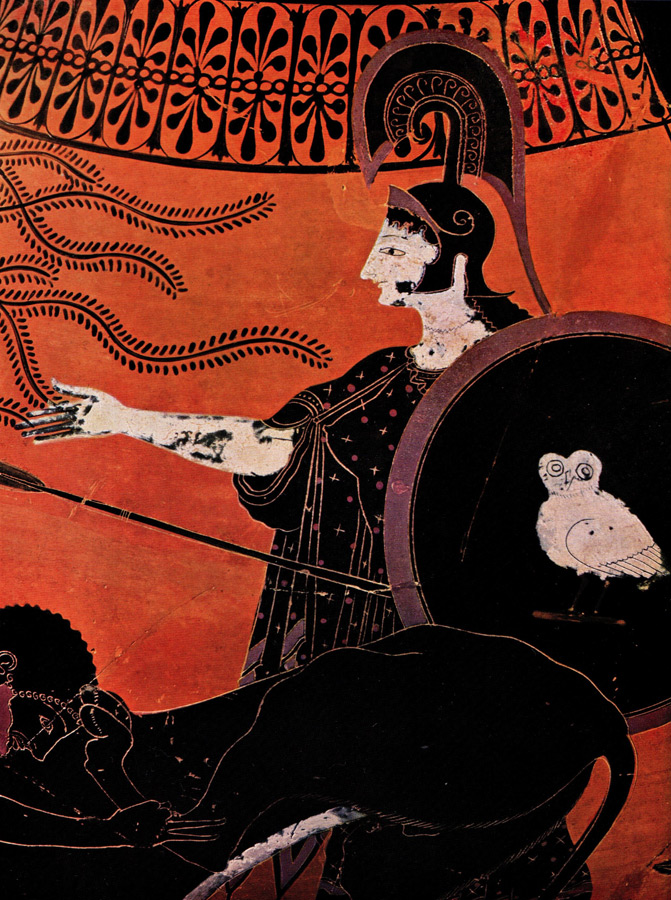
Definition
According to ancient sources, encaustic was the wax-based painting technique used by ancient Greek, Roman, and Byzantine artists . Encaustic was used in wall painting as well as in easel painting on wood and canvas, on ceramic , and in adding polychrome to sculptures and other objects of stone, metal and other materials. The ancient documentary sources reflect the wide use of encaustic by painters in classical antiquity: it is practically the only technique mentioned in connection with the execution of works of art , painters were called encausters or waxers, and the word wax was synonymous not only with encaustic , but also with painting .

Uncertainty around the composition of encaustic
The ancient sources do not make clear the exact composition of the paint. Current theories suggest the existence of two types of encaustic: a paint applied in molten state, made of pure beeswax or mixed with resin, and a cold encaustic, usually called Punic wax, based on an emulsion of beeswax treated with an alkali, which could be used alone or mixed with other binding media .
However, these theories have not been fully confirmed, and the composition of the ancient encaustic remains subject to debate . The uncertainty stems from the lack of cohesion of the wax emulsion, inappropriate for a pictorial medium, and from the difficulty in determining whether ancient encaustic works were painted with hot or cold encaustic .

Molten wax and cold wax techniques
Currently the molten wax technique is well known and used by many contemporary painters, especially since the introduction in the 20th century of portable electric heating implements which helped to solve some of the difficulties inherent in the technique. However, the composition of the ancient cold encaustic technique has been a constant source of controversy and disappointment. Until now, researchers had proposed essentially two types of media for cold encaustic:
- Beeswax dissolved in organic solvents
- Wax saponified with an alkali (sodium, potassium, ammonia) , often called Punic wax.
Encaustic with organic solvents seems to have been ruled out as a Greco-Roman technique, since such solvents would not have been available in paint until the Middle Ages.

The second hypothesis is based on the existence in Roman times of a type of wax called Punic wax, which in the opinion of various authors, was a saponified wax soluble in water. The problem, however, with this type of water-soluble encaustic is that wax treated with an alkali lacks cohesion, and the resulting paint detaches from the support when it dries, making it unfeasible as a paint medium. Its use in paint formulation is thus reduced to an additive, which could be incorporated in small amounts into a conventional medium -oil, casein, egg, gum, glue- but such a technique cannot be strictly considered as encaustic, as its main component is not beeswax.

Today we have a new cold encaustic technique, the wax-and-soap encaustic, a water-soluble paint with excellent characteristics as an artistic material, which can reproduce the brush and palette-knife strokes in the Fayum portraits, and whose main components have been identified in chemical analyses of Greco-Roman paintings.

Nature of Punic wax
The composition of Punic wax – cited by Pliny and Vitruvius in relation to the protection of walls painted with cinnabar – has raised endless controversy. Several authors have interpreted Punic wax to have been beeswax emulsified with an alkali. This emulsion would be the medium of a water-soluble encaustic. However, other studies have asserted Punic wax was merely bleached wax, insoluble in water . Both positions take as reference the text by Pliny that describes the method of manufacturing Punic wax, prepared by boiling the yellow wax in seawater mixed with a little nitrum and exposing it to the sun.
The origin of the controversy is due to the nature of the nitrum, which has been translated as sodium carbonate, sodium bicarbonate, potassium carbonate, potassium nitrate, sodium nitrate, or a combination of sodium carbonate, sodium bicarbonate, sodium chloride and sodium sulfate. If the nitrum used to make Punic wax was potassium carbonate, this could be a wax emulsion, but if it was potassium nitrate, Punic wax would be a bleached beeswax insoluble in water.

Although studies on the nitrum do not allow us to determine the nature of the Punic wax, other ancient texts may shed more light. Pliny places Punic wax at the top of the beeswax types classified according to their purity and whiteness, followed by Pontus wax, yellow in colour , which could indicate that Punic wax was bleached beeswax.
Exposure of beeswax to the sun causes discoloration, as does treatment with sodium chloride and potassium nitrate in boiling water. The result is, in Pliny’s words, “a wax of the greatest possible whiteness”.
The fundamental question in this discussion is as follows: if the goal of this process was to achieve a wax emulsion, Pliny would not advise boiling the wax in sea water, since sodium chloride breaks the emulsion. This is why modern formulations of wax emulsified with an alkali do not add sodium chloride to the mixture of beeswax and alkali in boiling water.

The text that best explains the nature of Punic wax comes from Dioscorides. He describes a treatment similar to that of Pliny and makes clear that the aim of this process is the bleaching of beeswax. He explains that the cakes of wax produced from the treatment with boiling water and seawater –or brine – are pierced with threads hung to expose the wax to the sun, indicating that the cakes were not of emulsified wax, which –unlike non-emulsified beeswax – cracks when it dries, and therefore cannot be hung on thread without falling on the floor .
If we consider that Punic wax was indeed bleached wax, it is understandable that ancient painters would prefer it to yellow beeswax in preparing their colours.

Water-soluble encaustic
A text providing more data on the nature of encaustic was written by Pliny the Elder: “there were two encaustic painting methods in Antiquity, wax cera and with cestrum, that is, vericulum, on ivory. When warships began to be painted, a third method was added, in which melted wax was applied with a brush. This boat paint was not affected by the sun, salt or wind” .
In the first part of this text, Pliny seems to suggest that the ancient artists painted with encaustic in two ways: with “the wax”, ie conventionally encaustic – taking the meaning of wax – or with a spatula –understanding cestro and vericulo to be palette-knifes, as in the reasoned translation by Cros and Henry .
According to this interpretation, encaustic would be applied in a conventional way –with a brush– and also with a spatula . In addition to this encaustic, there would be another, of a different nature, which differed from the previous type in that waxes were not applied cold but in a molten state, and had greater resistance to water, therefore being used to paint ships.
Other ancient texts seem to corroborate the notion that artists used a cold water-soluble encaustic, as it allowed the drawing of thin and long lines and could be cleaned with a sponge .

Heat curing of water soluble encaustic
The word encaustic can be translated as “burning-in”, which seems to imply the use of heat in the execution of works painted with this technique. Several ancient texts seem to support the application of heat in encaustic works.
References to the use of heat in ancient encaustic might suggest that that the paints had to be applied in a molten state.
However, Greco-Roman texts do not make clear whether heat was used to melt the paint before application, or whether it was used to fix the painting after completion of the work . Wax-and-soap encaustic requires a thermal curing to increase its water resistance, and molten wax encaustic also uses a final burn to fix the colours, so the word “encaustic” would be an appropriate term for both techniques.